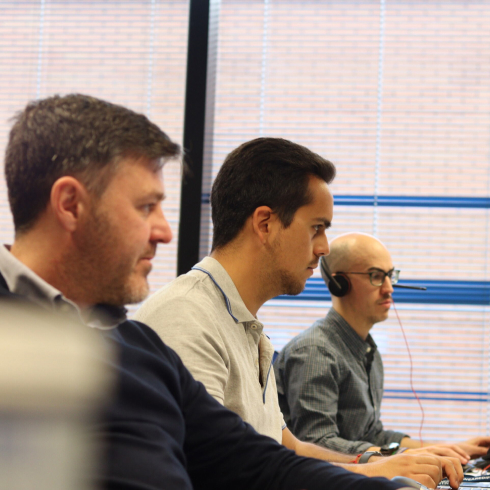We migrated 440 repositories to GitHub, improving the group’s management.
#WE ARE
DIFFERENT
#WE ARE
DIFFERENT
Ensuring the quality of your project
The pace of technological advancement today is unprecedented, placing a high resource cost on companies striving to stay ahead of digital trends. In this fast-evolving tech landscape, it's essential to integrate software quality assurance activities throughout the entire lifecycle to ensure that product quality remains uncompromised.
At hiberus, we have a specialized QA and Testing team, certified in ISTQB, with experience across multiple technology ecosystems and tools. Additionally, we are partners with Tricentis and have developed GEN QAI, our own Generative AI-based solution designed to optimize testing processes and take automation to the next level.
QA Governance
We analyze the technology context and implement measurable testing processes aligned with organizational goals.
- Configuration of project and test management tools
- Selection of KPIs and quality tracking metrics
- Creation and configuration of dashboards
- Verification of software delivery requirements
- Assurance and validation of QA and Testing procedures
- Identification of Quality Gates throughout the lifecycle
QA Consulting
We design and configure your quality control and testing strategy.
- Design and implementation of customized QA and testing procedures
- Selection of tools and frameworks for support and automation
- Design, execution, and evaluation of Proof of Concepts (POC)
- Design of Test Automation Architecture
- Process auditing, failure detection, and improvement recommendations
- Development of Quality Plans and Testing Policies
QA Operations
We define and execute test plans at all levels of the development cycle, covering different types of tests.
- Code Quality Analysis
- Functional Testing
- Test Automation
- Performance Testing
- Accessibility Testing
- Security Testing
- Integration of various tests within a CI/CD strategy
QA Training
We offer customized training in the latest techniques, methodologies, and solutions.
- Test skills development
- QA best practices
- Introduction to automation tools
- Integrating QA in CI/CD
- Risk identification and management
- Development of reports and metrics
What sets us apart

GEN QAI, our Solution to automate and accelerate project planning
Automate detailed plans in minutes, reduce costs and errors, and improve quality. Detect risks, optimize resources, and maintain full control. Want to transform your project management? Discover GEN QAI.

We are partners with Tricentis, the world leader in continuous enterprise testing.
Tricentis offers a new and different way to conduct software testing.
Their no-code, AI-driven automation approach enables both agile development and complex applications. As a result, it increases software delivery speed, reduces costs, and improves quality.
Technologies
We work with the leading technological tools in the market
Inspiring client success stories
Driving the success of leading international companies
#
THINGS
HAPPEN
HERE
Our track record in enhancing efficiency with QA
The people behind our success

“We manage projects in RPA, AI and Digital Transformation to increase business efficiency through technology.”
Antonio Puerta Gorjón
Commercial Manager of Enterprise Efficiency

"We study the latest technologies and Modern Work initiatives to ensure our clients stay connected and adapted to the digital workplace."
Raúl Gérez López
Global Head of Enterprise Efficience
Why hiberus
Leaders in technology
We are a globally recognized technology company. With 6 business areas and 42 areas of specialization, we can provide solutions for all your needs.
QA as a service
We focus on providing QA services and full QA management. We take charge of implementing your QA project, whether through resource provision or a closed project.
Methodology
Flexibility, customization, and easy implementation. We work with agile frameworks and methodologies, focusing on reusability.
Specialized team
We provide continuous training to our teams through QA hiberus University. Our teams are ISTQB® certified and possess cross-industry knowledge.
The latest news from hiberus
FAQ
This is a profile that analyzes and ensures quality in different types of products and services. QA stands for Quality Assurance, which is related to QM Quality Management and QC Quality Control.
Having a QA profile is essential from the beginning of the project, working in coordination with business, development, and design teams, among others. This professional can assist you from requirements gathering, preparation, planning, design, development, and launch of your services. Their presence prevents errors from appearing when the software reaches the market, reduces delivery times, saves on corrective action costs in the final stages of the process, and provides greater confidence in the quality and safety of the product.
For more information, you can consult this article on the QA analyst profile.
The ISO/IEC 25010 standard, System and Software Quality Models, can be applied as it describes the quality model for software products and for quality in use. This standard presents the quality characteristics and subcharacteristics against which software products are evaluated.
It is part of ISO/IEC 25000, known as SQuaRE (System and Software Quality Requirements and Evaluation), a family of standards that aims to create a common framework for assessing software product quality. The quality model defined by ISO/IEC 25010 is composed of eight characteristics that can be broken down into subcharacteristics for detailed analysis:
- Functional adequacy
- Reliability
- Usability
- Efficiency
- Compatibility
- Security
- Maintainability
- Portability
- For more information on QA standards, please consult the following article.
Quality assurance (QA) is the set of activities planned and systematically implemented to meet the quality requirements of a product or service. These activities include systematic measurement, comparison with standards, and process monitoring, which contribute to error prevention throughout the entire lifecycle.
According to a report by Capgemini and Microfocus, most organizations struggle to adapt their QA and testing processes to agile development. Reconciling the speed and frequency of testing with continuous release delivery requires increasing your organization's QA maturity or outsourcing it. This same report mentions that a large number of companies struggle with testing during sprints (56%) and that it takes a great deal of effort to find professionals with the knowledge to perform continuous software testing (62%).
For more information, you can consult this article on the importance of QA in agile methodologies, this article on trends and foresight in the QA world, and this article on Quality Assurance in e-commerce.
At an initial level, QA can be carried out with basic project management tools. However, as the QA maturity level of the organization and project evolves, the following tools can be implemented, classified by scope of work:
- Test management: JIRA, XRay, Zephy, Testlink, ALM
- Programming: Java, Python, Javascript
- Databases: SQL, Oracle, MySQL
- Frameworks: Appium, Selenium, Cypress, Junit, Testng
- Automation: Cucumber, Specflow, Behave, Selenium, Appium
- Codeless testing: NoCode/LowCode technology for codeless test automation
For more information on QA tools and skills, please refer to the following article.
- First, you must assess whether the organization's QA maturity level allows for automation. To do this, you need to analyze whether there is a product and a team with sufficient knowledge of manual test management.
- Then, you propose starting a pilot project on that limited product.
- Then, you plan to inventory metrics tailored to the company and project maturity, such as: testing hours, number of errors found by the client, number of errors found by development, system size, error detection time, etc.
- The people who will perform the automated testing must be assigned. Ideally, they should be familiar with the product, have performed manual testing on it, or have access to functional and product testing documentation.
- Next, the test cases to be automated are selected. If a battery of manual tests already exists, you can work from that list. It is important to classify the tests by type, because not all will be automatable, and some will be more easily automated than others.
- Classify tests into functional and non-functional (Reliability, Usability, Efficiency, Compatibility, Security, Maintainability, Portability).
- Once the test cases have been selected, prioritize and classify them according to characteristics: simple, repetitive, lower automation cost, greater business impact. The most common mistake is trying to automate everything. Automation can be done progressively.
- Depending on the test cases and the type of product, select the tools adapted to the scope and maturity of the pilot project.
- Prepare the environments, test data, and any additional tools that will be necessary.
- It is planned to begin automating a batch of no more than ten test cases.
- The entire process will need to be documented and tracked.
- For more information, you can consult this article on automation.
- Test Management and Quality Management Offices (TMO and QMO)
- CI/CD DevOps
- Testing strategy design
- Master test plan
- Test plan definition
- Test process assessment
- Testing tool assessment
- Test process implementation
- Functional testing
- Test automation
- Performance testing
- QA training in methodologies, tools, and processes














